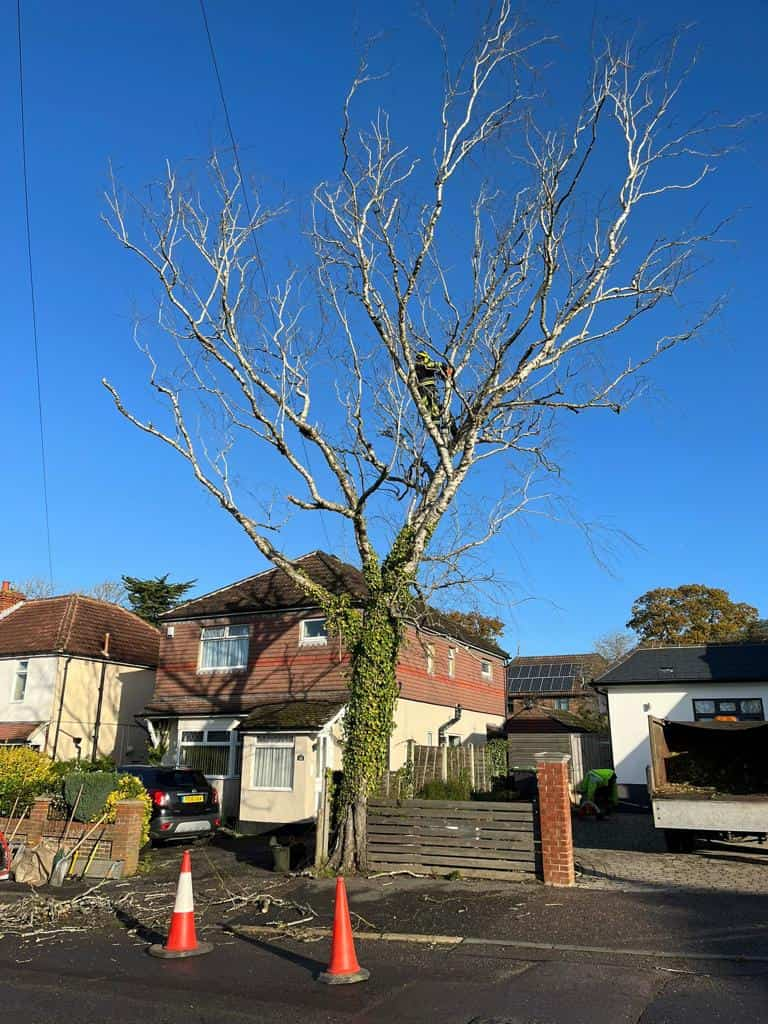Introduction: Proper tree pruning is crucial for maintaining your trees’ health, safety, and beauty. Different tree species require specific pruning techniques to thrive. At LM Tree Surgery Winchester, we specialise in tailoring our tree care practices to meet the unique needs of each tree species. This blog post will explore the best pruning techniques for various common tree species, ensuring your trees stay healthy and look their best.
1. Oak Trees
Oak trees are sturdy and majestic but require careful pruning to avoid disease and structural issues.
- When to Prune: Late winter to early spring, before new growth starts.
- Technique: Focus on removing dead or diseased wood and thinning out crowded branches to improve air circulation. Avoid heavy pruning, as oak trees are susceptible to diseases like oak wilt. Make clean cuts just outside the branch collar to facilitate healing.
2. Maple Trees
Maple trees are known for their vibrant autumn foliage. Proper pruning can enhance their natural beauty.
- When to Prune: Late winter to early spring, but avoid pruning in late winter if the sap flows heavily.
- Technique: Thin out dense canopies to allow more light and air to reach the inner branches. Remove dead or crossing branches and shape the tree to maintain its natural form. Use sharp tools to make clean cuts and avoid damaging the bark.
3. Fruit Trees (Apple, Pear, etc.)
Fruit trees require regular pruning to promote healthy fruit production and maintain shape.
- When to Prune: Late winter to early spring, before the growing season begins.
- Technique: Prune to create an open centre or modified central leader structure. Remove any dead or diseased wood, water sprouts, and suckers. Thin out crowded branches to improve sunlight penetration and air circulation, which helps prevent diseases and encourages better fruiting.
4. Coniferous Trees (Pine, Spruce, etc.)
Coniferous trees require minimal pruning, but occasional maintenance can help maintain their shape and health.
- When to Prune: Late winter to early spring.
- Technique: Remove any dead, damaged, or diseased branches. Avoid cutting into the central leader (main vertical stem) to prevent structural issues. Prune candles (new growth) for pines by cutting them in half to control size without harming the tree.
5. Birch Trees
Birch trees have delicate, papery bark and require careful pruning to avoid damage.
- When to Prune: Late autumn to early winter or spring before new growth.
- Technique: Remove dead, diseased, or crossing branches. Thin out the canopy to allow more light and air to reach the inner branches. Avoid heavy pruning, as birch trees can be sensitive to large cuts.
6. Willow Trees
Willow trees grow rapidly and require regular pruning to control their size and shape.
- When to Prune: Late winter to early spring.
- Technique: Remove dead, damaged, or crossing branches. Thin out the canopy to improve air circulation and reduce disease risk. Willows can handle more aggressive pruning, but avoid repeatedly cutting back to the same spot, as this can cause weak growth.
7. Evergreen Trees (Holly, Yew, etc.)
Evergreens add year-round greenery to your landscape and require specific pruning techniques to maintain their appearance.
- When to Prune: Late winter to early spring.
- Technique: Remove any dead, damaged, or diseased branches. Thin out the canopy if it becomes too dense. For shaping, make cuts just above a bud or branch junction to encourage new growth. Avoid cutting back into old wood, as evergreens may not regrow from older branches.
General Pruning Tips
- Use Sharp, Clean Tools: Sharp tools make clean cuts, reducing disease risk and promoting faster healing.
- Prune with a Purpose: Always have a clear pruning goal, whether removing dead wood, improving air circulation, or shaping the tree.
- Avoid Over-Pruning: Removing too much foliage at once can stress the tree and reduce its ability to photosynthesise. Stick to removing at least 25% of the canopy in a year.
Conclusion: Proper tree pruning is essential for maintaining your trees’ health, safety, and beauty. Understanding the specific needs of different tree species and employing the right techniques can ensure your trees thrive and enhance your landscape.
Call us on: 01962 571 792
Click here to find out more about LM Tree Surgery Winchester
Click here to complete our contact form and see how we can help you with your tree’s needs.

